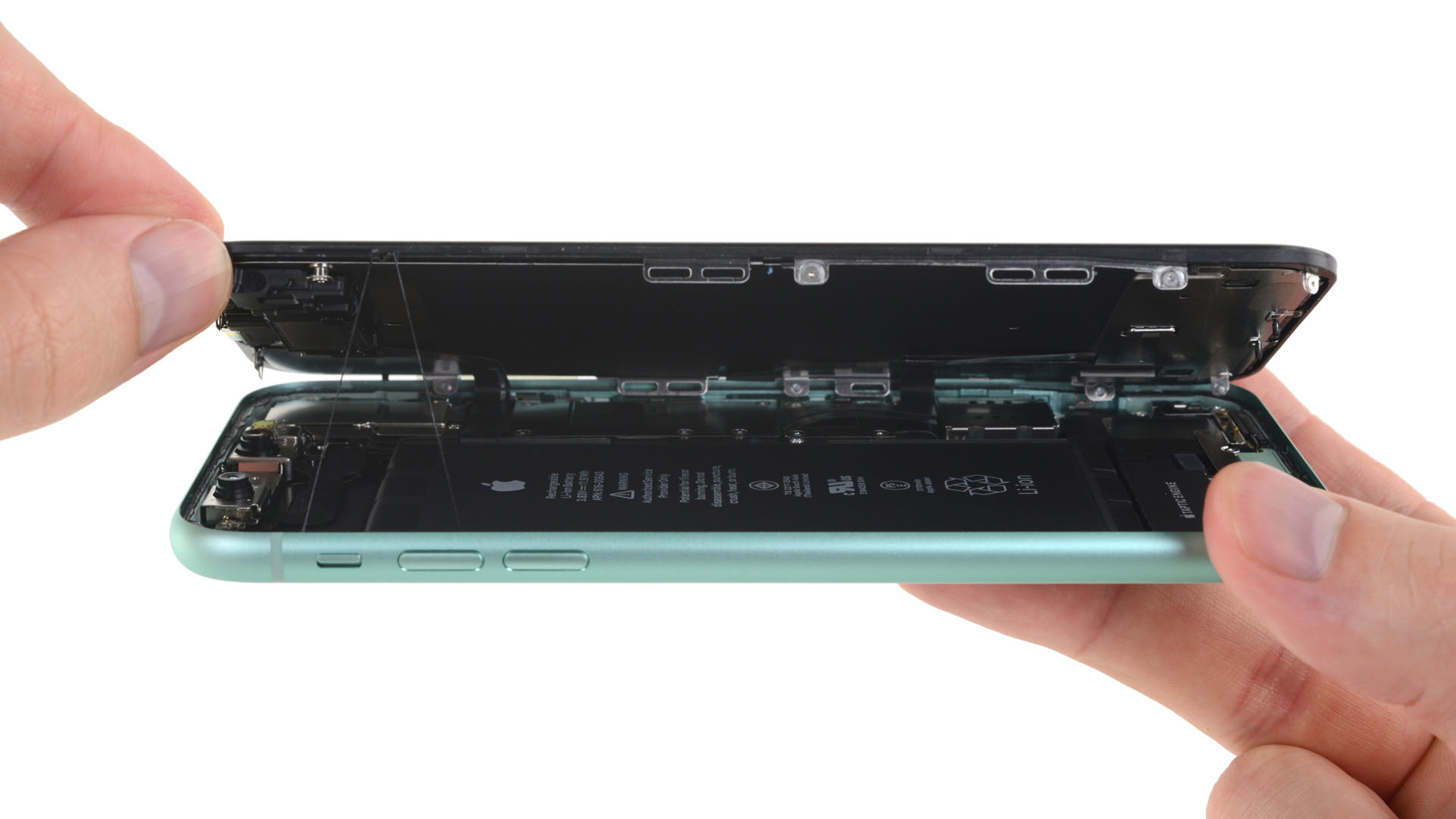For the first time ever, Apple released three new iPhones all at once, and our teardown team has never been busier. We focused most of our efforts on the iPhone 11 Pro Max teardown last week, but we also took a look inside the mid-sized and decidedly non-professional iPhone 11. This minty green machine may be the middle sibling in this year’s iPhone lineup, but it’s no less worthy of time under the screwdriver.

Looking at the exterior, the vanilla 11 casts off the “iPhone” labeling present on its predecessor, the iPhone XR, sporting only a centered mark of the Apple. The cameras undergo photogenic mitosis and are surrounded by what can only be described as a camera mesa (camesa?). The cameras multiply once more in the 11 Pro model, shown above to the right.

The logic determining what makes a smartphone “Pro” is still up in the air, but one thing is for sure: you don’t have to be a pro to open an iPhone these days. Ever since the iPhone 6S, the procedure for getting past an iPhone’s screen adhesive has been the same: heat, slice, repeat. And that’s despite the improved IP68 water and dust resistance over the IP67 iPhone XR. Just watch out for stray cables! Luckily, just like this year’s Pro series, the cables are aligned on one side this year.

As we slowly lift the screen out of the way, our first glimpse inside the iPhone 11 confirms our suspicions: this is an iPhone XR with some iPhone 11 Pro tech inside. Most notably: a new double-decker logic board, never before seen on the mid-size line. Unfortunately, the display is similar to its predecessors in that swapping it without Apple’s special tools disables True Tone—not unexpected, but disappointing nonetheless. But hey, at least the display is still user-swappable.

On the logic board, we identify a few chips and take some guesses as to what they might be. The APL1W85 is Apple’s A13 Bionic system-on-chip, layered over SK Hynix H9HKNNNCRMMVDR LPDDR4X RAM—SK Hynix’s documentation doesn’t contain a decoder for this model number, but it’s seemingly 4GB of the stuff. Rounding out the chips is a chip labeled H230FG82D6AD0-BC 922Y / M1TPAR31HA1 (probably storage) and another with a model number I7J9, perhaps Apple’s new U1 wireless positioning chip.

The rectangular battery is held in place with a total of six GBs of RAM (Gooey Battery strips), and unfortunately does not share the streamlined removal process that the Pro phones have—to comfortably remove all those adhesive strips, you’re going to have to remove the loudspeaker in addition to the Taptic Engine. That’s not to say that we don’t appreciate the stretch release adhesive—we <3 pull tabs!—but it does complicate the battery replacement process compared to its Pro siblings.
Apple boasted some small but worthwhile battery life improvements this year on the iPhone 11 (the Pro models got a bigger bump, but the XR was already ahead of the game in that arena, so the iPhone 11’s improvements are more subtle). We couldn’t resist lining the iPhone 11’s battery up with its predecessor and doing some measuring: this year’s battery measures 40.81 x 96.93 x 3.97 mm, and weighs 44.1 g. Compared to the XR’s battery, it’s ever so slightly smaller, but its capacity is 3110 mAh, which is about 7% more. That’s not huge, but probably accounts of the supposed hour bump the iPhone 11 gets over last year’s iPhone XR.

There’s only one connector on this rectangular battery, but it’s still included in Apple’s new hardware that improves battery health document, which is interesting. Maybe that means that the two cables in the 11 Pro were for bilateral charging after all, and there’s another health-boosting hardware difference the 11 line shares?

Though this phone isn’t pro enough to have a telephoto camera, it does still get the upgraded wide and ultrawide sensors and lenses that both Pro models enjoy. That means faster shutter speeds, a wider ISO range, and Night Mode capability.

X-rays show the promised optical image stabilization in the wide-angle module (the dark areas in the image are electromagnets). Meanwhile, the TrueDepth module’s flex cables have been rerouted and are no longer pinned under the battery—making for far faster and easier access during camera repairs.

With the rear case nearly hollowed out, we finish with an X-ray that leaves us with a few lingering questions. Despite the lack of a second battery connector, we can’t help but stare at this charging coil and wonder what might have been. If bilateral charging were included in the final production design, we wouldn’t necessarily expect to see a radically altered coil—but a bigger battery and additional thermal management would almost certainly be required, as reverse wireless charging is thirsty and inefficient, throwing off a lot of heat. In the case of the standard iPhone 11, we’re not seeing it.

And speaking of which: perhaps due to the lack of a second battery connector, we also see the omission of the new second tiny connection board we saw in the Pro Max. Oh tiny connection board, what was thy purpose? Were you, too, supposed to play a part in a feature whose curtains fell abruptly before it had a chance to prove itself?
Finally, just like the Pro and Pro Max, our handy X-ray shows what we think may be UWB-related antennas carefully embedded into the rear case.

The iPhone 11 earns a reparability score of 6 out of 10 (with 10 being the easiest to repair):
+ The prioritized display makes replacement of this critical component easier than in other devices.
+ Display swaps don’t require too much hardware swapping, so you can keep Face ID
+/- We prefer screws and non-adhesive fasteners over glue, but tiny proprietary screws are still hostile to repair.
+/- The high IP rating means your phone is better protected, but these measures also complicate repair.
– Front and back glass doubles the chances of breakage, and the rear glass can only be replaced with a full case swap.
6 out of 10 may not seem like anything to write home about, but in this day and age, it’s about as good as it gets for a non-Fairphone. There are many improvements we’d like to see, but hey—it could be worse.





8 commentaires
Does the board have the same layers of graphite thermal transfer material as on the PROs?
Miguel Ángel - Réponse
Could you measure the die size (die area) of the Apple A13 Bionic?
Ewout - Réponse
It looks like the dock connects to the top of the MLB, instead of be routed in behind like the iPhone 7 & 8, can you confirm?
The Stem - Réponse
Will you be posting a pic of the phone board, or can you confirm it’s identical to the 11 Pro Max which you did post?
sixshot8 - Réponse
Interesting but I’m lost. What’s the purpose of a tear down? Seems like I can’t use the information to better use the iPhone. And seems like a sad waste of money?
Treble Trouble - Réponse